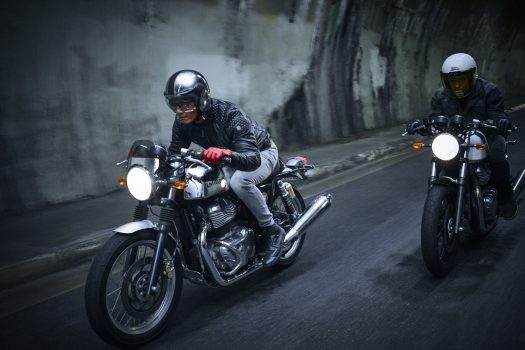Our stalwart contributor Blair Powell recently had a chance to test a part of his 2019 Royal Enfield Continental GT’s technology he hoped he’d never see: the anti-lock braking system. The owner of several classic machines of various vintages, Blair is not much for modern motorcycles, let alone the sort of computer-controlled safety features that may have saved his life in this instance. Now a man converted, Blair swears by the anti-lock system on his 650’s safety features. Here’s an excerpt from his near-miss experience with an inattentive driver.

The Magic Sorcery of Anti-Lock Brakes.
My current daily ride – a 2019 Royal Enfield GT 650 – is my first modern bike. I’ve owned old Triumphs, Hondas, and Ironhead Harley-Davidson Sportsters before this. Over beers at CRM HQ we were discussing the pros and cons of modern bikes and I said my favorite thing is the “it starts every time I push the button” bit, but someone asked about anti-lock brakes, so I had to tell my story.
This is my first bike with anti-lock brakes, and I have occasionally felt the back caliper click on if I hit a little gravel in a curve… but this time, the brakes really saved my backside. I was headed across town to my girlfriend’s DJ gig, riding through a busy commercial district. Traffic is going about 25-30 mph (40-48 kph for the rest of the world) when the fellow driving a car in front of me pulls off to the side of the street to park. But surprise -he was actually doing a U-turn, and swung right in front of me! I had about eight feet to stop so I grabbed as much brake as I could, heard the anti-lock system in both wheels clicking faster than a Buddy Rich drum solo, and stopped with inches to spare.
A few minutes later I arrived (alive!) at the gig, I asked James the bartender for one of his famous Mai Tais, and waited for my heart to stop racing.
I gotta say, the brakes on my old 1975 Honda CB550 (after rebuilding the calipers that always let in water, rusting the piston) or even the surprisingly good brakes on my ’79 Triumph Bonneville were nothing compared to the Enfield’s ByBre brakes. And if this had happened in my ’81 “our front disk brake is terrible, let’s make it dual disks and pair it with a rear disk that locks up if you just look at the pedal” Sportster, or my ’73 “Brakes are so bad you just gotta plan ahead” Sportster, I would have been sharing the front seat with this dude. I still love wrenching and riding on rickety old classics, but now I especially appreciate the new stuff.
Sidebar
How Anti-Lock Brakes Do Their Thing
The esteemed Mr. Powell’s hide was literally saved by a relatively new technology that manipulates the hydraulic pressure on his motorcycle’s brakes via sensors in each wheel that are connected to a control module embedded within his Enfield’s ECU (or electronic control unit.) The sensitive little gadgets mounted to each wheel resemble slotted metal rings bolted to the hubs and they provide constant, real-time feedback to the ECU. If a wheel (or wheels) are rotating at different speeds or slowing very quickly, the anti-lock system kicks in with a pump-and-valve system that manipulates the hydraulic pressure in each brake caliper. This is felt by the rider as a stuttering sensation which is the software/hardware combination preventing the wheels from locking up and possibly initiating a slide.
This technology is now standard on streetbikes and is particularly helpful in wet conditions where traction is compromised. Or when you’re late for a DJ gig cross town.







